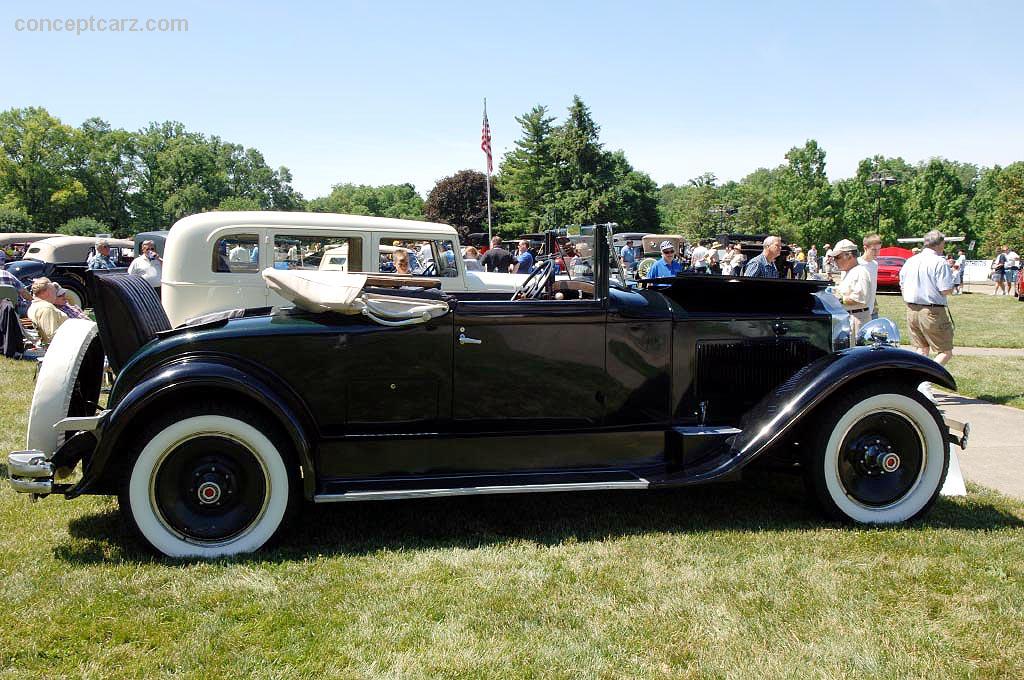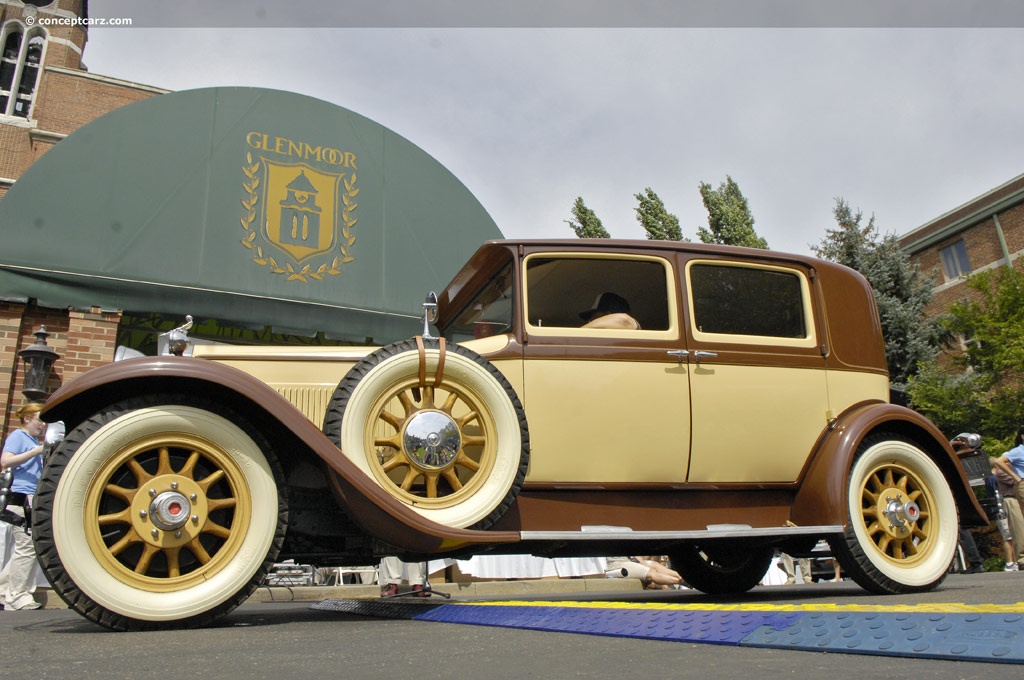Packard, for a period of time, was a very successful company, selling more automobiles than all other fine car brands combined. The Packards were popular with the social elite, the wealthy, captains of industry, and those who treasured quality automobiles. 
Convertible Coupe
View info and historyWith the introduction of the Seventh Series of Packards, the company introduced a single flowing fender line from the crown of the fender to the running board. Underneath the long, graceful bonnet was an eight-cylinder engine mated to a four-speed manual gearbox. The cars featured a Bijur chassis lubrication system and four-wheel assisted mechanical drum brakes. Amenities common to the vehicles were a single center driving lamp, white wall tires, cowl-mounted spotlights, grille guard, wind wings, and a single rear-mounted spare tire.The Seventh Series Packard Standard Eight was available in either the 127.5-inch form (known as the 726) or the 134.5-inch size (known as the 733). Compared to the previous year's Standard Eight model, the 1930s model grew by an inch due to the redesigned water pump, now with dual fan belts. The temperature control system was also new, shedding the previous motor thermostat in favor of thermostatically controlled radiator shutters. The hoods continued to wear louvered vents, and an accessory hood with three louver doors was also available, primarily for aesthetic purposes, giving the appearance of its larger siblings. In total, there were 15,731 Model 726 sedans produced in 1929 and 12,531 Model 733. The 726 was available only as a sedan, while the 733 was available as a Roadster, Phaeton, Sport Phaeton, 7-passenger sedan, sedan Limousine, 4- and 5-passenger coupe, club sedan, and 7-passenger touring car. Prices ranged from $2300 - $2775.
Club Sedan
View info and history Power was from a 319.2 cubic-inch straight eight L-head engine with nine main bearings, solid valve lifters, and a Detroit Lubricator updraft carburetor, and capable of producing 90 horsepower at 3,200 RPM. (The previous year's model had used a Packard updraft carburetor.) It was paired with a four-speed transmission, gaining an extra gear over the previous year, with a single-plate clutch. Mechanical brakes at all four corners provided the stopping power.The Eight-Cylinder Packard
From World War I, Packard models had used six-, eight-, and twelve-cylinder power at various times throughout the years, but by 1929, the company embraced a line of models that relied solely on eight-cylinder power. The 'lower' (albeit among the highest in the industry) priced models used a 319.2 cubic-inch straight-8 that offered 90 horsepower. The 'intermediate' and the 'top-of-the-line' models used a 384.4 cubic-inch unit with 130 horsepower. Both versions had nine main bearings and solid valve lifters. In 1931, the carburetor was switched to a Detroit Lubricator unit, and output from the 319.2 CID engine increased to 100 horsepower and the 384.8 CID to 120 bhp.
Club Sedan
View info and history1932 - A Year of Experimentation
Amid the Great Depression and in response to the so-called 'cylinder wars,' Packard expanded its lineup both with a low-priced and a much higher-priced range of models. The 'Light Eight' was the lower-priced option and used the 319.2 CID engine and styling that featured a distinctive 'shovel nose' appearance coupled with modern and elegant lines. The wheelbase size measured 127.75-inch and prices were in the $1,750 range. At the other end of the spectrum, Packard introduced a new twelve-cylinder model dubbed the 'Twin Six.' Its 445.5 cubic-inch engine had four main bearings, a Stromberg-Duplex carburetor, a cast iron monoblock with aluminum alloy pistons, 6.0:1 compression, and delivered 160 horsepower at 3,200 RPM. Wheelbase sizes included 142-inch and 147-inch platforms, and prices began at $3,650 and rose to over $7,950. The Light Eight failed to generate significant sales, perhaps due to not moving far enough down market, with its prices too close to other Packard models. Packard would make another attempt at infiltrating the low-priced market with the 'One Twenty' model of 1935. This time, they were successful, with an influx of sales that inspired them to introduce an even lower-priced six-cylinder option in 1937. The Packard Twin-Six (soon to be called the Packard Twelve) succeeded in catapulting Packard to the upper reaches of the luxury car segment with its powerful engine, elegant coachwork, and exclusivity. Produced in limited numbers, the Packard Twelve survived through 1939, after which the mantle of 'top-of-the-range' model was handed to the Super-8, powered by a 356 cubic-inch straight-8 developing 160 horsepower.
SedanPre World War II
With World War II on the horizon, Packard's lineup included a six-cylinder model that displaced 245 cubic-inches, had four main bearings, adjustable valve lifters, a Carter carburetor, and delivered 105 horsepower. The Packard Eight received a 282 cubic-inch inline-8 with five main bearings and 125 horsepower. The Packard Super-8 One-Sixty and Super-8 One-EIghty used a 356 CID inline-8 with nine main bearings, and hydraulic valve lifters and produced 165 hp. Post World War II
When peacetime resumed, Packard's lineup included the Clipper Six equipped with an L-head, inline-6 displacing 245.3 CID and delivering 105 hp. The 'intermediate' line (the Clipper Standard and Deluxe Eight) received an L-head, inline-8 displacing 282 CID and delivering 125 hp. The 'top-of-the-line' Super Clipper Eight and Custom Super Clipper Eight used 356 CID inline-8 with nine main bearings and hydraulic valve lifters, producing 165 hp at 3,600 RPM. 1947 was the final year of the six-cylinder Packard, relying solely on eight-cylinder power through its eventual demise in 1958.
by Daniel Vaughan | May 2009

Convertible Coupe
View info and history

Club Sedan
View info and history
From World War I, Packard models had used six-, eight-, and twelve-cylinder power at various times throughout the years, but by 1929, the company embraced a line of models that relied solely on eight-cylinder power. The 'lower' (albeit among the highest in the industry) priced models used a 319.2 cubic-inch straight-8 that offered 90 horsepower. The 'intermediate' and the 'top-of-the-line' models used a 384.4 cubic-inch unit with 130 horsepower. Both versions had nine main bearings and solid valve lifters. In 1931, the carburetor was switched to a Detroit Lubricator unit, and output from the 319.2 CID engine increased to 100 horsepower and the 384.8 CID to 120 bhp.

Club Sedan
View info and history
Amid the Great Depression and in response to the so-called 'cylinder wars,' Packard expanded its lineup both with a low-priced and a much higher-priced range of models. The 'Light Eight' was the lower-priced option and used the 319.2 CID engine and styling that featured a distinctive 'shovel nose' appearance coupled with modern and elegant lines. The wheelbase size measured 127.75-inch and prices were in the $1,750 range. At the other end of the spectrum, Packard introduced a new twelve-cylinder model dubbed the 'Twin Six.' Its 445.5 cubic-inch engine had four main bearings, a Stromberg-Duplex carburetor, a cast iron monoblock with aluminum alloy pistons, 6.0:1 compression, and delivered 160 horsepower at 3,200 RPM. Wheelbase sizes included 142-inch and 147-inch platforms, and prices began at $3,650 and rose to over $7,950. The Light Eight failed to generate significant sales, perhaps due to not moving far enough down market, with its prices too close to other Packard models. Packard would make another attempt at infiltrating the low-priced market with the 'One Twenty' model of 1935. This time, they were successful, with an influx of sales that inspired them to introduce an even lower-priced six-cylinder option in 1937. The Packard Twin-Six (soon to be called the Packard Twelve) succeeded in catapulting Packard to the upper reaches of the luxury car segment with its powerful engine, elegant coachwork, and exclusivity. Produced in limited numbers, the Packard Twelve survived through 1939, after which the mantle of 'top-of-the-range' model was handed to the Super-8, powered by a 356 cubic-inch straight-8 developing 160 horsepower.

Sedan
With World War II on the horizon, Packard's lineup included a six-cylinder model that displaced 245 cubic-inches, had four main bearings, adjustable valve lifters, a Carter carburetor, and delivered 105 horsepower. The Packard Eight received a 282 cubic-inch inline-8 with five main bearings and 125 horsepower. The Packard Super-8 One-Sixty and Super-8 One-EIghty used a 356 CID inline-8 with nine main bearings, and hydraulic valve lifters and produced 165 hp. Post World War II
When peacetime resumed, Packard's lineup included the Clipper Six equipped with an L-head, inline-6 displacing 245.3 CID and delivering 105 hp. The 'intermediate' line (the Clipper Standard and Deluxe Eight) received an L-head, inline-8 displacing 282 CID and delivering 125 hp. The 'top-of-the-line' Super Clipper Eight and Custom Super Clipper Eight used 356 CID inline-8 with nine main bearings and hydraulic valve lifters, producing 165 hp at 3,600 RPM. 1947 was the final year of the six-cylinder Packard, relying solely on eight-cylinder power through its eventual demise in 1958.
by Daniel Vaughan | May 2009
Similar Automakers
1930 Packard Series 733 Standard Eight Vehicle Profiles
Recent Vehicle Additions
Performance and Specification Comparison
Price Comparison
$3,200 - $3,900
$4,585 - $5,355
$5,203 - $6,020
Related Automotive News

AUCTIONS AMERICA KICKS OFF ITS 2016 SEASON WITH $20 MILLION IN SALES AND 40 PERCENT NEW BIDDERS AT FORT LAUDERDALE
Auctions Americas 14th annual Fort Lauderdale collector car auction generates %2420 million in sales
Diverse top-sellers list led by 1971 Ferrari 365 GTB4 Daytona at %24649,000
Rare American muscle and desirable Mercedes-Benzes attract significan...

FROM SHELBYS TO SUPERCARS, RM SOTHEBY'S ARIZONA SALE OFFERS ICONIC COLLECTOR CARS OF EVERY ERA
Pure adrenaline 1965 Shelby 427 Competition Cobra, 1963 Shelby 289 Cobra Dragonsnake, and 1964 Shelby 289 Cobra lead recent entries for RM Sothebys Arizona Biltmore sale, January 28-29
Auction features more than 125 motor cars and offers incr...

Concours d'Elegance of America at St. John's : Best of Show
The Concours dElegance of America, established in 1978, featured over 300 significant automobiles on the beautiful green at the Inn at St. Johns in Plymouth, Michigan. This years featured classes included Vintage Bentley, Auto Show 55, Bonneville...

Auctions America Continues Successful 2013 Season with its Annual Fall Carlisle Sale
Auctions America rounds out its 2013 auction season in Carlisle, Pennsylvania, October 3-4
Two-day Fall Carlisle sale, held in conjunction with the Carlisle Events Collector Car Swap Meet %26 Corral, features a diverse roster of 300 classics, exot...

The Champion in Touring Car Racing : The BMW M3
In August 1985, a rumour surfaced in motor magazine Auto-Deutschland which emanated from a new sports car. An A Group Car from BMW that was a thoroughbred racing car according to the rules but was also to be produced in a version licensed to drive on...





































